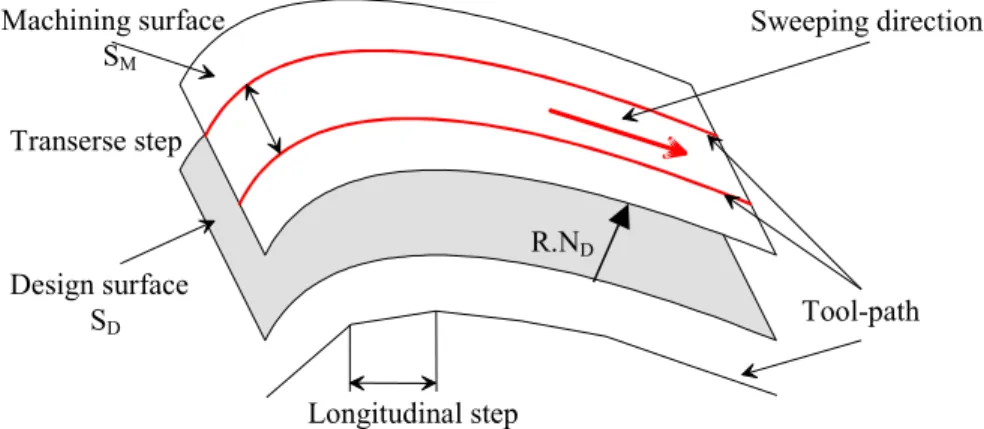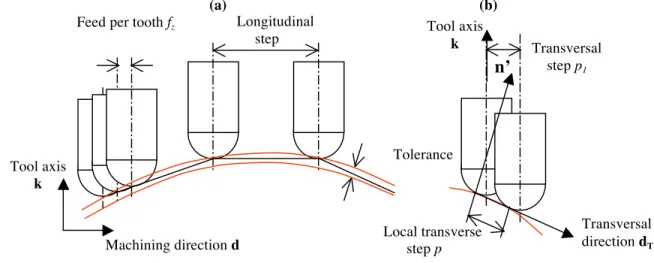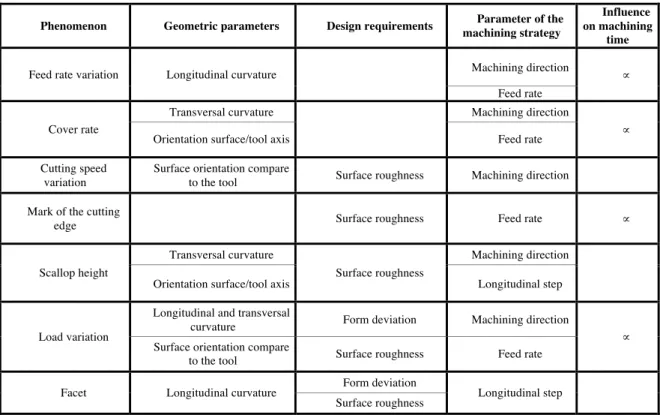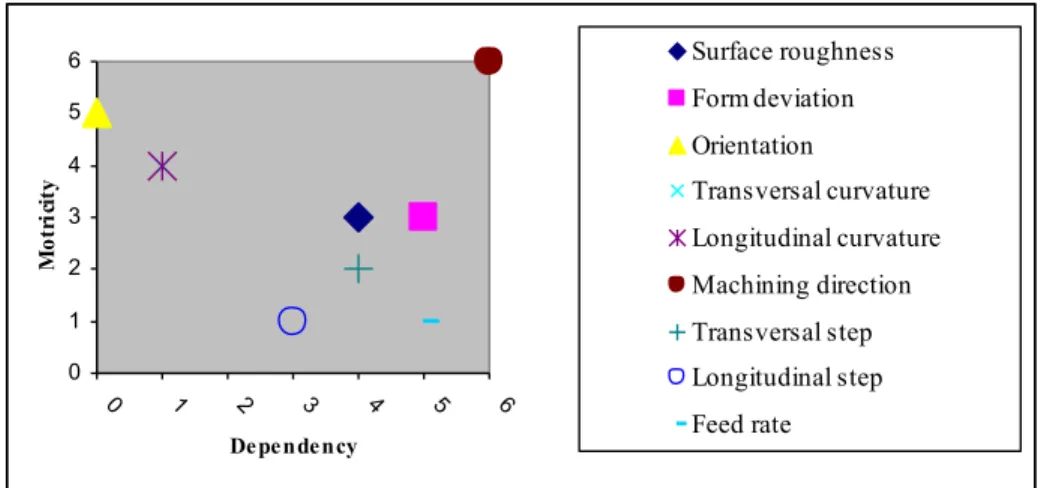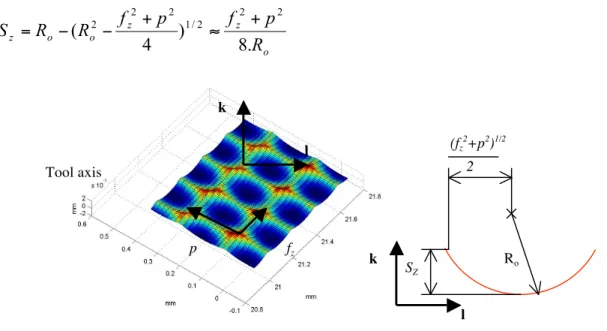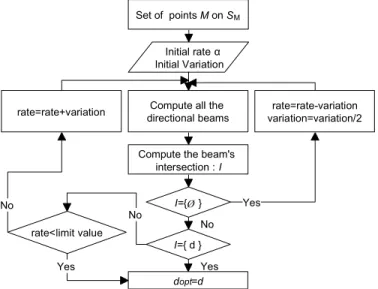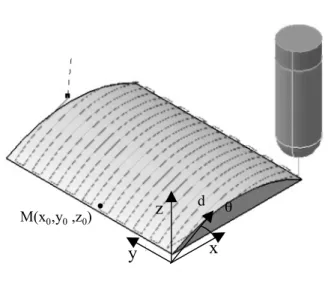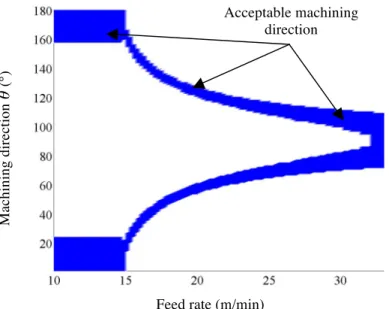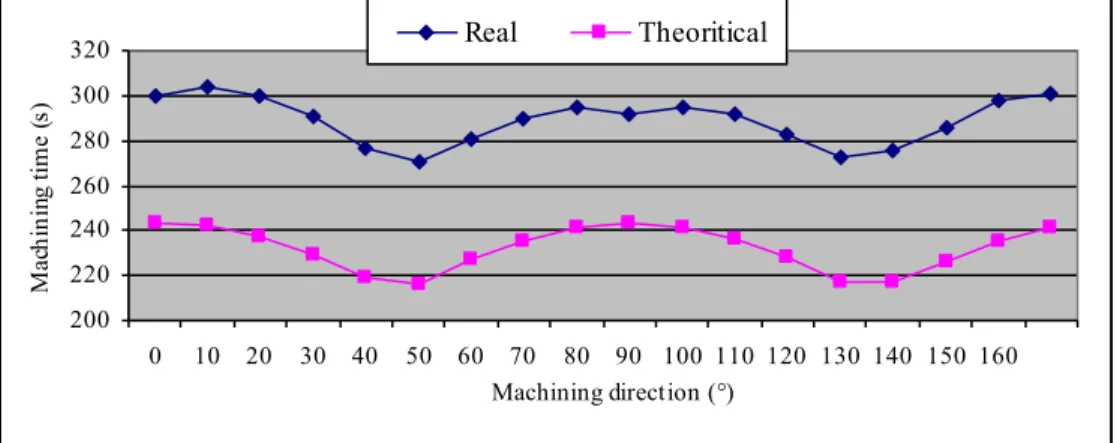HAL Id: hal-01154044
https://hal.archives-ouvertes.fr/hal-01154044
Submitted on 21 May 2015HAL is a multi-disciplinary open access
archive for the deposit and dissemination of sci-entific research documents, whether they are pub-lished or not. The documents may come from teaching and research institutions in France or abroad, or from public or private research centers.
L’archive ouverte pluridisciplinaire HAL, est destinée au dépôt et à la diffusion de documents scientifiques de niveau recherche, publiés ou non, émanant des établissements d’enseignement et de recherche français ou étrangers, des laboratoires publics ou privés.
milling of sculptured parts
Yann Quinsat, Laurent Sabourin
To cite this version:
Yann Quinsat, Laurent Sabourin. Optimal selection of machining direction for three-axis milling of sculptured parts. International Journal of Advanced Manufacturing Technology, Springer Verlag, 2006, pp.1132-1139. �hal-01154044�
Optimal selection of machining direction for three axis milling of
sculptured parts
QUINSAT Yann, SABOURIN Laurent LaMI IFMA/Université Blaise Pascal
Department of Machines, Mechanisms and Systems
Campus de CLERMONT-FERRAND / Les Cézeaux BP 265 63175 Aubière Cedex France E-mail: quinsat@ifma.fr
Tél. (33) 04 73 28 80 38, Fax (33) 04 73 28 81 00
ABSTRACT In the field of free form surface machining, CAM software allow to manage various
modes of tool-path generation (zig-zag, spiral, z-level, parallel plan, iso-planar, etc.) leaning on the geometry of the surface to be machined. Various machining strategies can be used for the same shape. Nevertheless the choice of a machining strategy remains an expert field. Indeed there are no precise rules to facilitate the necessary parameter choice for tool-path computation from the analysis of the numerical model of a part and the quality requirements. The objective of this paper is to provide a method to assist in the choice of the machining direction for parallel plane milling of sculptured parts. The influence of tool-path on the final quality according to the intrinsic geometrical characteristics of the latter (curves, orientation) was studied. The directionnal beam are introduced and defined from the local surface parameter. Finally a methodology to optimize machining time while guaranteeing a high level of quality was developed and applied to examples.
KEYWORDS Machining strategy, Surface roughness, Finishing process, Sculptured parts, three
axis milling
1 Introduction
In this paper, machining strategies for finishing processes of sculptured surfaces are studied. This research is especially focused on the choice of necessary parameter for tool-path computation in 3 axis milling. A machining strategy is a methodology used to compute an operation with the aim of carrying out a geometrical entity in its final form [1]. The choice of a machining strategy depends on various factors e.g. form deviation, surface roughness. The geometry of the tool, the cutting conditions (feed rate, cutting speed) and the adjustment parameters of the tool-path computation (transversal and longitudinal step, machining direction) are characterized by the machining strategy [2].
In a competitive climate, it is necessary to reduce the costs and respect the design requirements. So, the choice of a machining strategy is an optimization problem under constraints. This problem is based on the geometry of the manufactured surface. The machining time depends on the part geometry and the tool-path. The surface roughness and the form deviation are related to the machining strategy and the surface geometry.
The choice of a machining direction in order to optimize the machining time is studied under various headings:
− Reduction in effective machining time. The machining direction is chosen according to an increase in material removal rate (feed rate, tool engagement) [3,4]. Currently no methodology is presented to choose a machining direction for the whole surface.
−
Reduction in non-cutting time Tne. The machining direction is chosen to decrease non-cuttingtool-path [5].
Few formalized studies [6,7,8,9] presents methods to select a machining direction according to quality requirements of the machined surface. The reduction of the effective machining time leads to an increase in material removal rate. That requires an increase in the real feed rate and the transversal step.
The objective of this research work is to develop a methodology of machining direction selection according to the local parameters of the surface (curvature radius, orientation).
This choice allows an optimization of the machining time, while respecting the constraints on the manufactured surface. The selected machining direction has to minimize the machining time and respect requirements on the surface. Then we study the influence of the machining direction on the material removal rate A=fz.p and the relation between these same parameters and the surface
roughness.
1.1 Free form tool path computation
Machining of sculptured surface permits to obtain the part in its final form respecting the design requirements (form deviation and surface roughness). The main parameters are [2]:
− the machining direction, − the transversal step, − the longitudinal step.
Numerous tool-path computation methods are available in CAM software, such as z-level, parallel plane, iso-parametric. Some research work have been carried out in this field to create new methods or improve existing ones [10,11]. Contrary to the roughing process, the manufacturing time during finishing does not take priority over the geometric specifications of the surface.
Fig. 1. Description of the tool-path construction
Machining surface SM Design surface SD Longitudinal step Sweeping direction Transerse step Tool-path R.ND
Considering the method proposed by Kim and Kim [12], the tool-path (Fig. 1) is computed starting from an offset surface SM, theoretically defined by :
SM(u,v)=SD(u,v)+R.ND (1)
Where ND is the normal with SD at point SD(u,v) and R the tool radius. The normal of the surface can
be computed as :
v
v
u
S
u
v
u
S
v
v
u
S
u
v
u
S
v
u
N
D D D D D∂
∂
×
∂
∂
∂
∂
×
∂
∂
=
)
,
(
)
,
(
)
,
(
)
,
(
)
,
(
(2)The manufactured surface quality results from the linkage between the computed tool-path and the primary cutting motion. During the tool-path calculation, the theoretical path presented previously can not be directly communicated to the numerical control. The tool-path must be expressed according to an adapted interpolation format. In this way, the parameter of machining tolerance is defined to lcarry out the calculation. If the linear interpolation is used, the machining tolerance (Fig. 2a) allows to calculate the longitudinal step between two successive positions of the tool. The longitudinal step is computed according to the curvature radius of the tool path [13]. The higher the radius of curvature, the larger the longitudinal step.
In addition, the machining of the surface is obtained by sweeping, it remains a material scallop due to the form and the dimension of the selected tool. The scallop height can be parameterized by a transversal step. The transversal step p1(Fig. 2b) is defined in a plane perpendicular to the tool axis k,
the local transversal step pis defined in the plane (n’,dT).
Fig. 2. Parameter description
Considering the cutting motion, the feed rate and the rotation of the tool must be taken into account. This periodic phenomenon is combined with the tool-path to generate the machined surface. If the longitudinal step is larger than the feed rate, the tool-path computation error [2] is of a higher order than surface roughness (Fig. 3).
Tool axis
k
Tolerance Feed per tooth fz
Machining direction d Transversal step p1 Transversal direction dT
n’
Local transverse step p (a) Longitudinal step (b) Tool axis kFig. 3. Surface roughness and tool-path generation error
The machining strategy parameters could be modified to decrease the machining time and respect the design requirements (form deviation and roughness). Next table (tab. 1) shows that all the different parameters influence machining time and surface quality.
Phenomenon Geometric parameters Design requirements Parameter of the machining strategy
Influence on machining
time
Feed rate variation Longitudinal curvature Machining direction ∝
Feed rate Cover rate
Transversal curvature Machining direction
∝
Orientation surface/tool axis Feed rate
Cutting speed variation
Surface orientation compare
to the tool Surface roughness Machining direction
Mark of the cutting
edge Surface roughness Feed rate ∝
Scallop height
Transversal curvature
Surface roughness
Machining direction
Orientation surface/tool axis Longitudinal step
Load variation
Longitudinal and transversal
curvature Form deviation Machining direction
∝ Surface orientation compare
to the tool Surface roughness Feed rate
Facet Longitudinal curvature Form deviation Longitudinal step
Surface roughness
Table 1. Links between the parameters
1.2 Influence of the machining direction
To highlight the interrelationship between the parameters, the MICMAC method is applied [14] from the previous table (Tab. 1). Two characteristics are used to ensure the classification : motricity and dependency. The motricity of a variable corresponds to the number of parameters influenced by a variation this one. Conversely the dependency of a variable is the number of parameters which could modify the latter. It is then possible to classify the set of parameters according to their motricity and
Design surface Manufactured surface Longitudinal step Roughness step Tool-path
Feed per tooth
their dependence. Indeed, figure 4 shows that the machining direction is the most significant parameter concerning machining time and surface roughness variation and highlights that :
− the machining direction is a key parameter in the choice of a machining strategy,
−
the motor parameters (parameters with the highest motricity) are the geometrical parameters, surface orientation compared to the tool, the transversal and the longitudinal curvature of the tool-path.Fig. 4. Motricity and dependancy of the parameters
The machining direction is one of the most important parameters for the reduction of the machining time (Fig. 4). Usually [3,4,15] this direction is chosen according to an optimal feed rate or depth of cut. And there is no methodology linking the surface and the the machining strategy parameters with surface roughness requirements.
Only a few research works present methods for the optimal choice of the machining direction. Chiou et al. [4] propose to define locally the machining direction allowing to increase the radial step. The tool-paths are then computed by connecting the different points using a curve tangent to these directions. Feng et al. [15] define for each point the machining direction allowing to maximize the feed rate while respecting the form deviation. They analyze the variation of the cutting forces according to the surface (approximated locally by a plane) and the machining direction.
Chen et al. [3] define a machining direction allowing the greatest material removal. This direction is defined by the greatest depth of cut according to a defined deviation. For each point, they show that this direction corresponds to the projection of the surface gradient on an orthogonal plane to the tool axis.
The objective of this work is to reduce the machining time by increasing the material removal rate. However, locally, this material removal rate is proportional to A=p1.fz. p1 is the transversal step on the
surface, and fz is the programmed feed rate. But p1 is directly associated [15]to the machining direction
at a given point according to the studied surface. So this work proposes to choose the optimal machining direction according to the feed rate, the transverse step and the geometry of the surface.
Initially a model of surface roughness is defined. This model permits to define the acceptable maximum transverse step at each point of the surface. From this maximum step a fitness function could be introduced. This function will define the influence of a machining direction over the machining time. 0 1 2 3 4 5 6 0 1 2 3 4 5 6 Dependency Mo tr ic it y Surface roughness Form deviation Orientation Transversal curvature Longitudinal curvature Machining direction Transversal step Longitudinal step Feed rate
2 Surface roughness criterion
The objective is to define a criterion of surface roughness according to the surface geometry and the machining direction. Various studies on the characterization of the influence of the orientation of a ball end mill tool were undertaken. Some studies have an experimental point of view [6,7] and are more interested in observing the wear of the tool than the final surface quality. Other studies [16] analyze the mark left by a tool for various slopes and propose a model to predict the surface quality, but the criterion of surface roughness used is along one direction and not directly defined from the surface. The model defined by Kim [17] and developed in a previous work [18] shows that the pattern obtained is constructed from numerous spherical segments. The radius of this segment is the tool radius Ro. This pattern depends only on the feed rate (fz), the local transverse step (p) and the radius of the tool (Ro).
Currently there is no standardized criterion to describe this pattern. Moreover, traditional criteria of characterization [19] (Ra, Rt defined in ISO 4287) do not highlight the link between the feed rate (fz) and the transversal step (p) [20,21] because of their uni-directional definition. To define the surface roughness corresponding to this pattern, the criterion used is the surface criterion Sz [22] defined in the
standard draft ISO 12085. This parameter corresponds to the height deviation between the lowest and highest points of the surface. For a spherical segment of Ro radius, and dimension fz and p, the
maximum height Sz is expressed by (Fig. 5):
o z z o o z
R
p
f
p
f
R
R
S
.
8
)
4
(
2 2 2 / 1 2 2 2+
≈
+
−
−
=
(3)Fig. 5. Computation of the maximal deviation
3 Real feed rate and machining time
At first approximation, the real feed rate is considered equal to the programmed feed rate during machining. In this case, the real feed per tooth fz is equal to the programmed one without any influence of the selected machining direction. In this case, the machining direction which minimizes the tool-path length, minimizes the machining time.
But the study of the high speed milling machine shows that the real feed rate is not always equal to the programmed one. The feed rate evolution depends on the power of the motion axes used and in
Ro SZ l l k Tool axis k fz p (fz2+p2)1/2 2
particular of the jerk value, maximum acceptable accelerations and speeds. According to the literature [23], the two principal factors of deceleration are:
− the tool-path continuity, − the tool-path curvature radius.
In the case of sculptured surface, the tool-paths are assumed to be continuous and only the tool-path curvature radius is taken into account. According to maximum axis acceleration and the local curvature radius Rc of a tool-path, the maximum real feed per tooth is given by:
N
Z
a
R
f
a
R
V
c z c f.
.
.
max max max max=
⇒
=
(4)Thus, for a given point of surface, if the machine needs to slow down, the feed per tooth is reduced. Hence the surface roughness criterion Sz presented in 3 is reduced but the selected direction of machining can be less powerful.
4 Definition of a machining direction
The objective of this work is to propose a method for machining direction choice. The direction chosen allows at the same time:
− to ensure the respect of roughness requirement by modelling the local surface roughness,
− to reduce the machining time, by evaluating the real feed rate at any point and choosing the suitable machining direction.
The presented method permits to determine the most powerful machining directions (minimizing the machining time) according to the local surface parameters. The concept of directional beam is introduced. These beams are defined starting from a fitness function. This fitness function highlights the performance of a machining direction related to the machining time. The directional beams represents for a point the set of acceptable machining directions, i.e. the set of machining directions allowing a satisfactory level of performance.
Then the concept of the directional beams is used in order to establish criteria of surface feasibility. The methodology suggested determines the set of the machining directions maximizing the performance criterion.
4.1 Fitness function
To define the most powerful machining direction, the fitness function is introduced. This function links the machining direction at a point and the cutting parameters with time reduction. This function is described by:
(
)
(
)
⎟
⎟
⎠
⎞
⎜
⎜
⎝
⎛
→
ℜ
)
,
,
(
,
,
,
,
P
M
d
G
P
M
d
P
S
D
p c M!
(5)D is the set of machining directions and d a direction in D. M is a point on surface SM. Finally, PC
represents the set of cutting parameters (fz, transversal step) and P is an element of this set. This
function GP expresses the performance at point M on the surface SM of a machining direction d for
parameters P.
A reduction in machining time could be achieved by increasing the material removal rate. Thus the fitness function could be defined by:
z P c
G
d
M
P
p
f
P
M
D
P
M
d
,
,
)
(
,
,
)
(
,
,
)
.
(
∈
=
1∀
(6) Fig. 6. Definition of βLocally, the tool-path is assumed to be defined on the tangent plane of the surface. The transverse direction dT and the vector n’ (Fig. 6) are defined by:
dT = ((d×n)/( d×n ))
n = dT ×d
(7)
Where d is the machining direction.Generally, using β as β=cos-1(|n .k|), the local transversal step could be defined by p=p1/cos(β) [15]. The effective height of pattern Sz is specified in the preceding
paragraph. At the considered point M:
Sz=(((p1²/cos²β)+fz²)/(8.Ro)) (8)
β directly depends on the machining direction selected and on the normal the surface at the considered point M. Replacing β in the equation 8, the calculation of the satisfactory step at the point considered M becomes:
(
)
2 2 2 18
.
.
.
.
⎟
⎟
⎠
⎞
⎜
⎜
⎝
⎛
⎟
⎟
⎠
⎞
⎜
⎜
⎝
⎛
×
×
×
−
=
d
k
n
d
n
d
f
R
S
p
z o z (9)The maximum feed rate of the machine tool depends on the maximum acceleration of the slowest axis of the machine and also on the curvature radius Rc of the tool-path [23]. This speed is expressed
by:
max
max
R
.a
V
f=
c (10)This enables us to evaluate the real feed rate of the machine at the determined point with a defined speed Vf programmed by:
Local transversal step p Transversal step p1 Transversal direction dT n’ k β
fz=min(Vf programmed/Z.N, Vfmax/Z.N) (11)
A fitness function taking into account the constraint of surface roughness could be defined by:
(
z o z)
z P z P C Mf
k
d
n
d
n
d
f
R
S
P
M
d
G
f
p
P
M
d
G
P
S
D
P
M
d
.
.
.
.
.
8
)
,
,
(
.
)
,
,
(
)
,
,
(
)
,
,
(
2 1⎟
⎟
⎠
⎞
⎜
⎜
⎝
⎛
⎟
⎟
⎠
⎞
⎜
⎜
⎝
⎛
×
×
×
−
=
=
∈
∀
(12)4.2 Definition of the directional beams
For a given point M on the surface and fixed cutting parameters P, it is possible to define direction d which maximize the fitness function GP. The maximum of GP is noted:
Gpmax(M,P)=maxd∈D(GP(d,M,P))|(M,P) fixed (13)
From this maximal value, the machining direction d which enables us to obtain this maximum value, are gathered in a set Dmax(M,P). It is defined by:
Dmax(M,P)={d∈D, GP(d,M,P)= Gpmax(M,P)} (14)
Directional Beam: A directional beam is a set of machining directions for a given point M and
cutting parameters P. The fitness function GP is close (with a coefficient α) to its maximal value Gpmax for all directions.
Fd(M,P)={d∈D, Gpmax(M,P)-GP(d,M,P)≤(1-α).Gpmax(M,P)} (15)
These beams enable to introduce flexibility in the choice of machining direction. They describe the concept of neighborhood between two machining directions.
If two points M1 and M2 present two beams (Fd(M1,P) and Fd(M2,P)) non-disconnected, they could
be machined with a common machining direction. This direction guarantees a machining time close to the optimal value in M1 and M2 (Fig. 7).
4.3 Machining feasibility criterion
To determine a machining direction for all points SM, it is sufficient to calculate the beam
intersection. We note:
)
,
(
M
P
d
F
I
M S M∩
∈=
(16)− If I≠{φ} then a machining direction permits to machine the surface close to the optimal fitness at each point. All the direction in I are suitable.
− If I={φ} then no machining direction permits to machine the surface close to the optimal fitness at each point for a rate α.
x
x
y
y
Machined surface
Acceptable machining direction
Directional beams Fd(M,P) Points M
(a) (b)
Fig. 7. Optimal machining direction (a) I≠{φ} (b) I={φ}
If the beam intersection is not empty, the selected direction guarantees that for each point the fitness function is close to its maximum (Fig. 7). But there is no guarantee that the direction chosen is the best one. To find the best direction, we must increase α in order to reduce the directional beams.
4.4 Algorithm of choice
The optimal machining direction must be located at the beam’s intersection and maximized the rate α. To determine this direction, the algorithm described in figure 8 is proposed. This algorithm begins with a low value of α. Then this value is increased in order to reduce the number of elements at the intersection. If the intersection turns empty then the step chosen to increase rate α is reduced and the process starts again. This algorithm maximizes α and determines a machining direction close to optimal (Gpmax) at any point.
Set of points M on SM
Initial rate α Initial Variation
Compute all the directional beams Compute the beam's
intersection : I I={Ø } I={ d } rate=rate-variation variation=variation/2 rate=rate+variation rate<limit value dopt=d Yes No Yes Yes No No
5 Application
5.1 Case 1The previous methodology is now applied on a first example (Fig. 9). For a given point on the surface, the machining direction is defined by d with d=(cosθ,sinθ,0)T. θ defines the orientation of d from the x axis in the (x,y) plane.
The machined surface is defined as a portion of acylinder of axis y and radius Rcyl. In a coordinate
system (x,y,z) with z as the tool axis, this surface is written as: 2 2
x
R
z
=
cyl−
(17)x
z
y
θ M(x0,y0,z0) dFig. 9. Description of the cylinder milling
For a machined surface SD defined previously, the radius of curvature Rc of the tool-path at a given
point (x0,y0,z0), is expressed according to the selected machining direction d and the surface
parameters.
(
)
θ
θ
2 2 0 2 2.
.
sin
cos
1
x
R
R
R
c=
−
cyl+
tool−
(18)The direction along the cylinder axis can increase the feed rate. Indeed, in these directions the tool-path curvature is null and the programmed speed is reached at each point. On the other hand, the transversal direction penalizing for speed allows a greater transversal step. A large radius of cylinder makes it possible to obtain the programmed feed rate apart from the selected direction. In this case the optimal machining direction d should be the transverse one.
The previous algorithm is applied to this surface for a ball end tool of diameter 10 mm (Rtool=5 mm),
a roughness criterion Sz=0.01 mm, a radius of cylinder Rcyl=10 mm and a maximum acceleration of 3
m/s². The results obtained are represented in figure 10. This figure describes the acceptable machining direction according to the programmed feed rate.
D
ire
cti
on d
’us
ina
ge (°
)
Vitesse d’avance (m/min)
Fig. 10. Optimal machining direction according to the feed rate These results highlight that:
− In the case of low programmed speeds, the transverse direction (0° and 180°) is not very penalizing for the feed rate of the machine. The optimal direction is this one because it allows the greatest transversal step.
− In the case of high programmed speeds, the maximum speed of the machine is more significant on the choice of machining direction. The optimal direction is maximizing the real feed rate. So the optimal machining direction is parallel to the cylinder axis.
5.2 Case 2
x
yz
d θFig. 11. Description of the machined surface (case 2)
This method has been tested on the surface defined in figure 11. This surface is contained in a parallelepipede of 100×100×15 mm³. To machine this surface, the tool used is a 10 mm diameter (Rtool=5 mm) ball-end mill with a feed per tooth fz=0.2 mm/tooth. The algorithm ends up in a direction
of θ=45°.
In order to check this result, tool-paths have been programmed on CAM software (Catia V5). The feed rate used was 6000 mm/min (N=15000 rpm). For these cutting conditions, timekeeping on
Acceptable machining direction
Feed rate (m/min)
Ma ch in in g d ir ec ti o n θ (° )
machine tool (HURON KX15 with a Siemens 840D numerical control unit) were carried out. Figure 12 shows the real (time keeping on machine tool) and theoretical (time given by CAM software) machining time evolution according to machining direction. The lowest machining time is obtained for an orientation of θ=50°. This orientation is closed to the optimal machining direction of the algorithm. The results confirm a notable reduction in real machining time (12%) with an orientation of θ=50° compared to θ=90°. The difference between the theoretical and real machining time is constant. This gap comes from the the tool-path linking. The curvature radius of the linking shape imposes a feed rate reduction. 200 220 240 260 280 300 320 0 10 20 30 40 50 60 70 80 90 100 110 120 130 140 150 160 Machining direction (°) Ma ch in in g tim e (s ) Real Theoritical
Fig. 12. Machining time evolution
6 Conclusion
In the framework of 3-axis milling of a sculptured part, the machining direction is a key parameter of the machining strategy. The choice of this direction should make it possible to reduce the total machining time, while respecting the surface requirements.
The objective of the presented work is to propose a methodology to the machining direction choice. This choice is carried out by respecting the surface roughness requirements and by assessing the real feed rate at each point.
The concept of directional beam has been introduced in this article. These beams represent in each point the set of machining directions guaranteeing a maximum rate of performance. The intersection of this beams defines a set of optimal machining directions. From this intersection a machining direction is selected on the surface. This methodology is applied to simple case. The results correspond to expected ones and highlight the best machining directions according to the programmed feed rate.
The presented method of direction choice is currently being validated on a simple case and is going to be applied on more complex parts like forging dies and thus to be able to provide an assistance tool to C.A.M programming.
REFERENCE
1. Sun G, Sequin C H, Wright P K (2001) Operation decomposition for freeform surface feature in process planning. Computer aided Design 33:621-636.
2. Lartigue C, Duc E, Tournier C (1999) Machining of Free-Form Surfaces and Geometrical Specifications. Proc Instn Mech Engrs 213:21-27.
3. Chen Z, Dong Z, Vickers G W (2003) Automated Surface Subdivision and Tool Path Generation for 3 1/2 1/2 axis CNC Machining of Sculptured parts. Computer in Industry 50:319-331.
4. Chiou C- J, Lee Y S (2002) A Machining potential field approach to tool path generation for multi-axis sculptured surface machining. Computer Aided Design 34:357-371.
5. Held M, Arkin E M, Smith C L (2001) Optimization problems related to zigzag pocket machining. Algorithmica 26:219-236.
6. Kang M C, Kim K K, Lee D W, Kim J S, Kim N K (2001) Characteristics of inclined Planes According to the Variations of the cutting direction in high-speed ball-end milling. International Journal of Advanced Manufacturing Technology 17:323-329.
7. Ko T J, Kim H S, Lee S S (2001) Selection of the machining inclination angle in high-speed ball end milling. International Journal of Advanced Manufacturing Technology 17:163-170.
8. Lee C M, Kim S W Choi K H, Lee D W (2003) Evaluation of cutter orientations in high-speed ball end milling of cantilever-shaped thin plate. Journal of Material Processing Technology 140:231-236.
9. Ramos A M, Relvas C, Simões.A (2003) The influence of finishing milling strategies on texture roughness and dimensional deviations on the machining of complex surface. Journal of Materials Processing Technology 136:209-216.
10. Kim T, Sarma S E (2002) Toolpath generation along directions of maximum kinematic performance; a first cut at machine-optimal paths. Computer Aided Design 34:453-468.
11. Tournier C, Duc E (2002) A surface based approach for constant scallop height. International Journal of Advanced Manufacturing Technology 19:318-324.
12. Kim K I, Kim K (1995) A new machine strategy for sculptured surface using offset surface. International journal of Production Research 33:1683-1697.
13. Choi K, Jerard R B (1998) Sculptured surface machining theory and application. Kluwer Academic Publisher.
14. Godet M (2000) The Art of Scenarios and Strategic Planning: Tools and Pitfalls. Technological Forecasting and Social Change 65(1):3-22.
15. Feng H –Y,Su N (2000) Integrated tool path and feed rate optimization for the finishing machining of 3D plane surfaces. International of Machine Tools and Manufacture 40:1557-1572.
16. Bouzakis K -D, Aichouh P, Efstahiou K (2003) Determination of the chip geometry, cutting force and roughness in free form surfaces finishing milling, with ball end tools. International Journal of Machine Tools & Manufacture 43: 499-514.
17. Kim B H, Chu C N (1998) Texture prediction of milled surface using texture superposition method. Computer Aided Design 31:485-494.
18. Quinsat Y, Sabourin L, Gogu G (2004) Help for sculptured surface machining strategy choice: application to finishing process of sculptured surface. Current advances in mechanical design and production 8:1023-1031. 19. Gadelmawla E S, Koura M M, Amaksoud T M, Elewa I M,Solima H H (2002) Roughness parameters.
Journal of Materials Processing Technology 123:133-145.
20. Dong W P, Sullivan P J, Stout K J (1992) Comprehensive study of parameters for characterizing three dimensional surface topography I: Some inherent properties of parameter variation Wear 159:161-171. 21. Dong W P, Sullivan P J, Stout K J (1993) Comprehensive study of parameters for characterizing three
dimensional surface topography II: Statistical properties of parameter variation. Wear 167:9-21.
22. Dong W P, Sullivan P J, Stout K J (1994) Comprehensive study of parameters for characterizing three dimensional surface topography IV: Parameter for characterising spatial and hybrid properties.Wear 178:45-60.
23. Pateloup V, Duc E, Lartigue C, Ray P (2003) Pocketing optimization for HSM. Geometry tool path and interpolation mode influence on dynamic machine tool behaviour. Machine Engineering 3:127-138.
